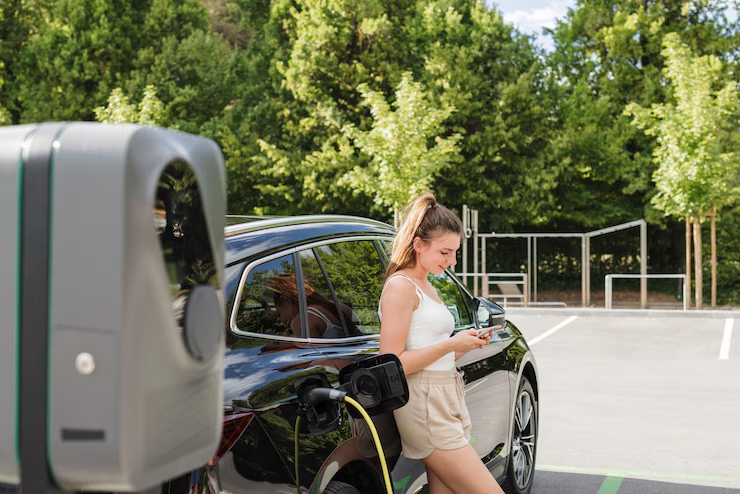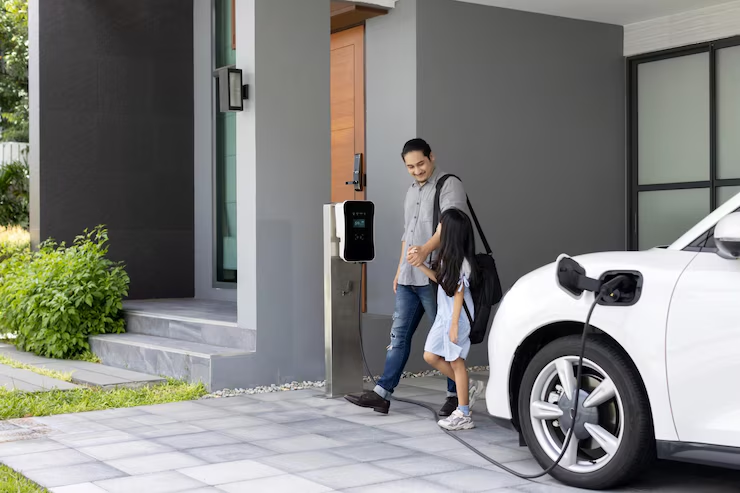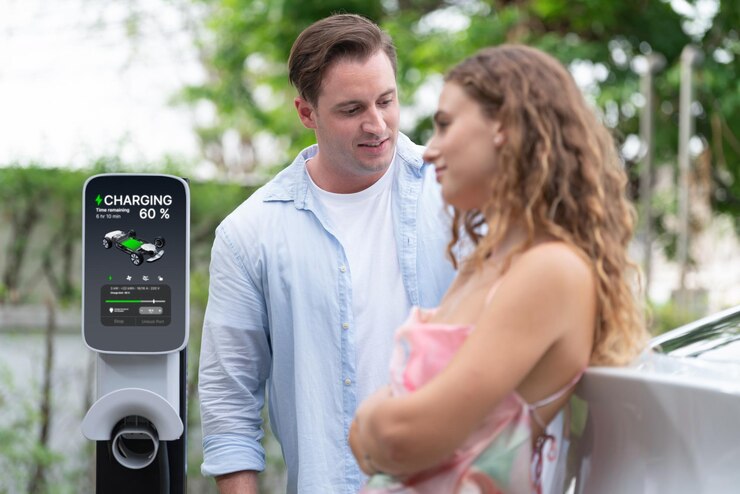Introduction
Electric vehicles (EVs) are no longer a niche market theyre going mainstream fast. Understanding EV Charging A Beginners Guide With increasing environmental awareness government incentives and technological advances, more people than ever are switching to electric cars However one of the most common concerns for new EV owners is How do I charge it
If youre just stepping into the world of EVs understanding charging might feel overwhelming From different charger types and levels to plug compatibility and charging costs there a lot to grasp. But don’t worry w’ve got your back. This guide breaks it all down in plain simple English. So lets plug in and get started!
EV Charging
EV charging is the process of replenishing your cars battery by connecting it to an electrical power source. Think of it like charging your smartphone only on a much bigger scale. Just like there are different phone chargers (USB-A USB-C Lightning), EVs also have different connectors and charging speeds.
Types of Electric Vehicles
Before diving into charging its important to know the type of EV youre dealing with
Battery Electric Vehicle (BEV)
Runs entirely on electricity
Needs regular charging from the grid
No gas engine at all
Plug in Hybrid Electric Vehicle (PHEV)

Uses both electric power and gasoline
Can drive on battery alone for a limited range
Switches to gas once battery runs low
Examples Toyota Prius Prime Ford Escape PHEV
Hybrid Electric Vehicle
Charges its battery through regenerative braking
Cannot be plugged in
Runs mostly on gas but is more fuel-efficient
Examples Honda Insight Toyota Camry Hybrid
Your vehicle type will influence your charging habits, needs, and costs.
Levels of EV Charging
Not all charging is created equal EV charging is typically divided into three levels
Charging The Slow Lane
Uses a regular 120V household outlet
Adds about 3–5 miles of range per hour
Takes 24–48 hours for a full charge
Best for PHEVs or light daily driving
Level 2 Charging The Sweet Spot
Requires a 240V outlet (like an oven or dryer)
Adds about 20 30 miles per hour
Takes 4–8 hours for a full charge
Ideal for overnight home charging or workplaces
Level 3 / DC Fast Charging The Speedster
Uses direct current (DC) instead of alternating current (AC)
Adds 100+ miles in under 30 minutes
Usually found on highways and public charging networks
Not all EVs support DC fast charging
Common EV Charging Connector
Just like wall sockets differ around the world so do EV plugs Here’s a quick guide:
Type 1 (SAE J1772)
Standard for Level 1 and Level 2 in North America
Compatible with most EVs except Tesla
Type 2 (Mennekes)
Common in Europe for Level 2
Not usually found in the US
CHAdeMO
Fast charging connector
Used by some Nissan and Mitsubishi vehicles
Being phased out in favor of CCS
CCS (Combined Charging System)
Rapidly becoming the global standard
Combines Level 2 and DC fast charging
Used by most new non Tesla EVs
Tesla Connector (NACS)
Teslas proprietary plug in North America
Can be used with adapters by other EVs
Home Charging The Convenient Way

Home charging is one of the best parts of owning an EV. Its like waking up every morning with a full tank
How to Set Up a Home Charger
Install a dedicated 240V outlet
Buy a Level 2 charging station (smart or basic)
Hire a licensed electrician for safe installation
Mount the charger in your garage or driveway
Cost of Home Charging
Equipment $300–$800
Installation $500–$2,000
Electricity Varies usually $0 10–$0 25 per kWh
Smart Chargers
Smart chargers connect to your Wi-Fi and let you
Schedule charging during off-peak hours
Monitor energy use
Get alerts when your car is fully charged
Public Charging Charging on the Go
When youre away from home or on a long trip public chargers become essential.
Where to Find Public Chargers
Shopping malls
Hotels
Workplaces
Highway rest stops
Top Charging Networks
ChargePoint
Electrify America
EVgo
Blink
Tesla Superchargers
Apps like PlugShare and ABRP A Better Route Planner can help locate chargers and plan trips
Cost of Public Charging
Public chargers are often more expensive than home charging:
Level 2 $0.20–$0.40 per kWh or per hour
DC Fast Charging $0 40–$0 70 per kWh or $5 $20 per session
Some businesses offer free charging as a perk for customers
How Long Does It Take to Charge an EV
Charging time depends on three things
Battery size (kWh)
Current battery level
Charging speed (Level 1 2 or 3)
Typical Charging Times
Charging Level Charging Time (0%–80%) Range Added per Hour
Level 1 24–48 hours 3–5 miles
Level 2 4–8 hours 20–30 miles
DC Fast 20–45 minutes 100+ miles
Pro Tip EVs charge fastest from 0–80%. After that, speed slows to protect the battery.
EV Charging Myths Busted
Lets bust some common misconceptions:
EV Charging is Inconvenient
Not true. Over 80% of EV charging is done at home. With growing infrastructure public chargers are more accessible than ever
EVs Cant Go on Long Trips
Also false. With range improvements and fast chargers along highways, long road trips are totally doable. Apps help plan routes with charging stops.
All EVs Use the Same Charger
Nope. Connector types differ. Know your cars plug and bring an adapter if needed.
Battery Health and Charging Tips
Your EV’s battery is its most valuable component. Here’s how to keep it healthy:
Dos
Keep charge between 20–80% for daily use
Use Level 2 for most charging
Charge during off-peak hours
Donts
Avoid frequent full charges unless needed
Dont leave the car at 0% or 100% for long
Minimize use of DC fast charging unless on trips
EV Charging and the Environment
EVs are already cleaner than gas cars but charging with renewable energy makes them even better. Consider:
Installing solar panels at home
Choosing utility plans with green energy options
Using eco friendly routes in navigation apps
Government Incentives and Rebates
Many countries offer
Tax credits for EV purchases
Rebates for home charger installation
Discounts on electric utility rates
Check your local governments website or speak with your utility provider for available perks.
Tips for First Time EV Owners
Plan ahead Learn where your nearest chargers are
Get a Level 2 charger Worth every penny
Use charging apps They’re your new best friend
Keep an adapter in your trunk: Just in case
Take it easy Range anxiety fades quickly
Conclusion
Switching to an electric vehicle may seem like a leap into the unknown, but once you get the hang of EV charging, its really not that complicated. With just a little knowledge about charger types connector compatibility charging levels and best practices for battery health youll find that powering an EV is as routine as plugging in your phone.
From convenient home setups to expanding public infrastructure EV charging offers flexibility savings and environmental benefits that traditional fuel cant compete with. Whether youre a curious beginner or a new EV owner understanding how charging works puts you in the drivers seat both literally and figuratively.
So, take the plunge. Your journey into the world of electric mobility is not only possible its practical efficient and part of a greener future.

